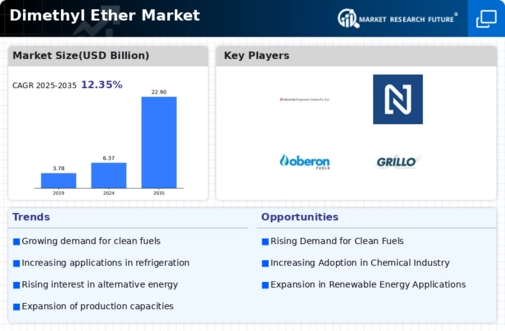Market Share
Dimethyl Ether Market Share Analysis
The Asia-Pacific region stands out as a potential powerhouse in the Dimethyl ether (DME) market, primarily due to the substantial Liquefied Petroleum Gas (LPG) deficits in countries like China, Korea, India, Japan, and Indonesia. These countries, while lacking significant natural gas resources for DME production, boast abundant coal deposits, making DME production economically advantageous in the region. The availability of vast coal resources allows companies to delve into DME manufacturing with favorable economics, ensuring easy and cost-effective raw material sourcing. The combination of immense demand potential and rich coal deposits is prompting market players in the region to invest significantly in DME facilities, catering to the current market and establishing a robust foundation to capture a substantial market share in the future. The economic viability of DME production in the Asia-Pacific region is underscored by the advantageous position of countries with substantial coal reserves. This allows companies to venture into DME manufacturing with lucrative margins, as the raw materials are easily accessible and cost-effective. Consequently, the region is witnessing a surge in investments as market players strive to meet the current demand and position themselves strategically for a dominant market share in the future.
As environmental concerns escalate, regulatory bodies are compelled to address the pressing issue of harmful emissions. The surge in carbon dioxide (CO2) emissions has led regulatory bodies worldwide to institute stringent emissions norms for vehicles and industries, aiming to mitigate the adverse impact of pollutants on air quality. Various associations and concerned authorities are intensifying their efforts to establish a robust foundation for clean-burning fuels.
Dimethyl ether (DME) has emerged as a dependable alternative fuel in response to the increasing focus on environmental sustainability. Its ability to enhance the burning quality of LPG in terms of emissions, when blended appropriately, positions it as a valuable component in the pursuit of cleaner fuels. Notably, DME has demonstrated its potential to replace diesel with minimal modifications required in the engine. With an almost similar cetane number to diesel and carbon emissions 44.0% lower than those from diesel, DME aligns with EURO IV standards without necessitating any modifications.
The Asia-Pacific region is poised to become a major player in the DME market, driven by significant LPG deficits and abundant coal deposits in countries like China, Korea, India, Japan, and Indonesia. The favorable economics of DME production in the region, coupled with the imperative to address environmental concerns, is prompting substantial investments from market players. DME's versatility as a clean-burning fuel, capable of enhancing the burning quality of LPG and serving as a potential diesel substitute, positions it as a key player in the quest for environmentally sustainable energy solutions.








Leave a Comment